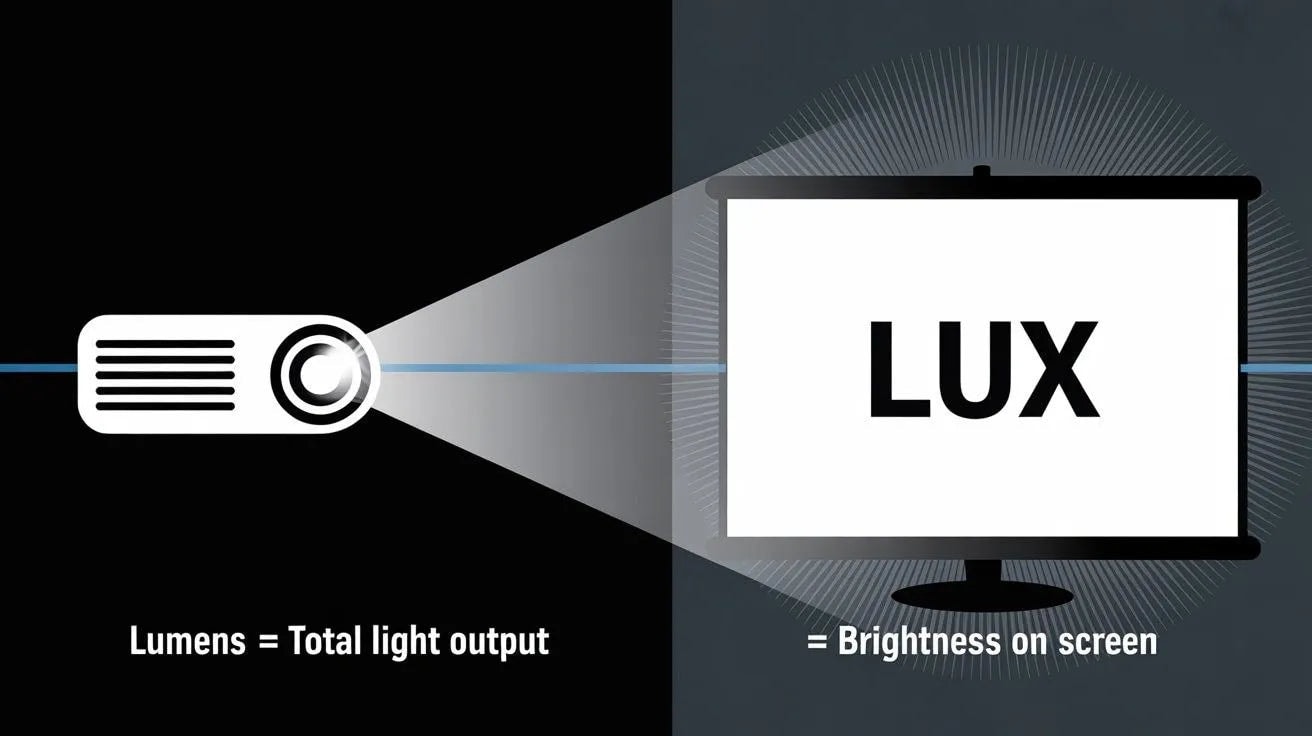What Are Lumens?
When you spot lumens on projectors, it points to the total light output a projector can generate. Picture it as a sprinkler: lumens are like the total water volume spraying from the sprinkler head. The official standards to measure this are ISO lumens or ANSI lumens, which ensure you can compare measurements across different brands .
A projector's brightness, measured in lumens, plays a crucial role in its performance. Higher lumen ratings result in a brighter image, which is essential to keep clarity and color saturation in rooms with ambient light or when you project onto a bigger screen. To evaluate the overall brightness capability of different projector models, comparing lumens is the simplest approach.
For example, a high-end projector like the Valerion VisionMaster Max delivers 3,500 ISO lumens, making it an excellent choice for a large, well-lit living room. In contrast, a model like the StreamMaster Plus 2, which offers 2,000 ISO lumens, is perfect for a dedicated home theater or a smaller room where you can control the lighting. This difference highlights the importance of aligning a projector's lumen count with your specific viewing environment.
What Is Lux?
Lux for projectors measures how bright light is on a specific area. While lumens show the total light output, lux tells us how that light spreads out. Picture our sprinkler example: lux would be the water you gather in a bucket placed at a certain spot. We figure out lux as lumens per square meter, so it shows you how bright an image will look on the screen.
The brightness you see on a projector screen, measured in lux, depends a lot on how you set things up. When you project 2,000 lumens onto a small screen, the light bunches up giving you a higher lux reading and a picture that looks brighter. On the flip side, if you spread those same 2,000 lumens across a big screen, you'll get a lower lux reading and an image that looks dimmer. This is why the distance between your projector and screen, along with the size of your screen play such a big role.
You won't see lux and lumens listed together on a projector's specs. Instead, lux helps you grasp the actual brightness of your setup after you've picked a projector based on its lumen count. It's a real-world measure that lets you guess how bright your projected image will look showing how important your screen size and room setting are.
Lux vs. Lumens: Main Differences
The main difference between lumens and lux is what they measure. Lumens tell you how much light a projector makes, while lux shows how bright that light is on a surface. A projector like the Valerion VisionMaster Pro2, which has 3,000 ISO lumens always has the same lumen rating. But the lux value changes depending on your setup. If you spread those 3,000 lumens across a big screen, you'll get a lower lux reading than if you project them onto a smaller screen. This matters a lot when you're trying to understand lux vs lumens for projectors and want to get the right brightness for your home theater.

Lumens and Lux: Key Factors for Your Home Theater
When you pick a projector for your home theater, you need to find a balance between what your projector can do and where you'll watch movies. The lumen rating of a projector serves as your starting point.
- Dark rooms: 1,000–2,000 lumens.
- Semi-lit rooms: 2,000–3,000 lumens.
- Bright rooms: 3,000+ lumens.
But lumens don't paint the full picture of lux and how bright a projector appears. A projector with high lumens can still produce an image that looks dim if it's shown on a big screen. This is where lux comes into play measuring how intense the light is on the surface. You can figure it out with this simple math:
Lux = Lumens ÷ Screen Area (m²)
This shows that the same number of lumens will result in a lower lux value on a bigger screen making the image look dimmer.
To maximize your setup's potential, think about using a lux meter to measure the light in your room. This will help you figure out how many lumens your projector needs to overcome the existing light and create a movie-like picture.
Common Misconceptions About Lux and Lumens
Misconception 1: "More lumens always mean a brighter image."
Higher lumens do provide more light, but how bright the image appears (in lux) depends on the size of the screen. A projector with high lumens can appear dim if you use too large a screen.
Misconception 2: "Lux is listed in projector specs."
Projector specs, including those from Valerion, show ISO lumens. Lux varies and you can figure it out based on your screen size and throw distance.
Misconception 3: "Lumens and lux mean the same thing."
These terms measure different things. Lumens show the total light output from the projector, while lux shows how bright that light looks on a specific surface.
The Final Thought
Knowing the difference between lux and lumens helps create a great home theater. Lumens show your projector's total light output, while lux tells you how bright the image looks on your screen.
By checking your room's lighting and screen dimensions, you can pick a projector with enough lumens to create an engaging viewing setup.
To learn more about setting up the ideal home cinema, check out the Valerion blog.






